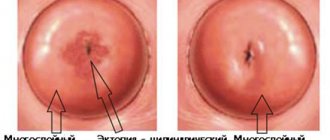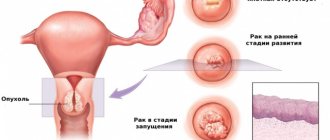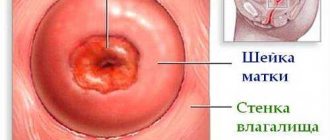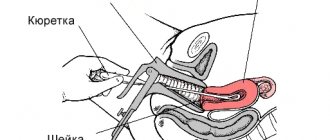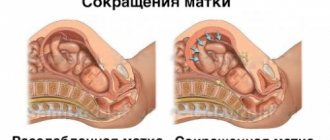Examination
Gynecologists use two methods for research:
- Visual – carried out manually by a doctor on a gynecological chair.
- Carrying out an ultrasound using a transvaginal sensor is a more reliable method; it determines the size up to mm. Typically performed in the second trimester.
Favorable results of gynecological examination:
- length of the cervix during pregnancy is more than 36 mm.
- Dense to the touch.
- Closed external opening. For the organ of a woman giving birth again, penetration of the fingertip is allowed.
Based on the resulting sum of estimates of size, location and density, 3 degrees of maturity are distinguished:
- Immature – total value 0-2 points.
- Not mature enough – final score 3-5 points.
- Mature – the sum of points is more than 6.
Pregnancy and the cervix
The cervix is not just the vestibule of the uterus. This organ plays an important role both throughout the nine months of gestation and during childbirth. What is the uterine cervix? This is a muscular organ of dense structure, the vaginal part of which is seen by the doctor during a gynecological examination with a mirror. Normally, the length of the cervix varies between 3.5-4.5 cm. The part of the cervix facing the vagina is called the external os. In women who have not given birth, it is closed. After the first birth, it may be slightly open and allow the tip of the finger to pass through. In the absence of any violations, the cervix remains dense and long until the onset of labor, since its main task is to hold the baby in the uterus. Then it softens and smoothes out, and during contractions the pharynx opens from 2 cm to 10 cm. Then, when “the path is open,” the baby is born. After childbirth, the cervix returns to its original state. If dilatation occurs before 36-37 weeks, the consequences for the baby may not be very good.
Determination of the condition and length of the cervix during pregnancy
Checking the condition of the cervix is the key to a successful pregnancy. However, this does not mean that every visit to the gynecologist for 9 months a woman should undergo an examination in a chair. There are two ways to determine the condition of the uterine cervix and its length:
- Manual examination on a gynecological chair. At the same time, the doctor evaluates the length of the neck, its “consistency” - how soft the organ is, and also checks the condition of the external pharynx. If everything is in order, then the result of the examination should have the following content: data on the length of the cervix - more than 3.5 cm, the structure is dense, the external pharynx is closed (or the tip of the finger is missing - for women who have already given birth).
- The second way to assess the condition of the uterine cervix is to perform an ultrasound using a transvaginal sensor. Ultrasound assessment of cervical length during pregnancy is often more reliable, because The doctor indicates the length of the neck with an accuracy of mm. When assessing the state of cervical length before the 20th week of pregnancy, the data obtained should not become fundamental during the diagnosis (with the exception of critical indicators), since during this period the cervix can be changeable. The assessment of the condition must be comprehensive and combine an analysis of all factors. At more than 20 weeks, the length of the cervix can be assessed using a transabdomial sensor.
As a result of examination of the cervix (visual or using an ultrasound machine), the degree of its maturity is determined. Based on the length of the cervix during pregnancy, as well as other factors, there are 3 degrees of maturity:
- If the final score varies from 0 to 2 points, the uterine cervix is immature.
- The result is in the range of 3 - 5 points - ripening (insufficiently mature) cervix.
- A total score of more than 6 means the cervix is mature.
The assessment data is summarized based on the length, position and smoothness (consistency) of the cervix.
Depending on the period at which signs of cervical maturity were first identified, as well as the degree of their severity, doctors make a prognosis for the further course of pregnancy. It is important to remember that shortening of the uterine cervix, regardless of gestational age (up to the 37th week), is an alarming signal that necessarily requires additional attention and control. Ignoring this factor can lead to sad consequences - miscarriage in the early stages of pregnancy or premature birth if we are talking about the third trimester of pregnancy.
Cervical length during pregnancy by week: pregnancy forecast
Despite the peculiarities of the course of pregnancy and individual differences between women, doctors have identified standards that the cervix must meet at different stages of expecting a child. Most often, the length of the cervix is measured after the 20th week of pregnancy, but if indicated, the examination can be carried out earlier. The data is systematized in the form of a table of cervical length during pregnancy.
As can be seen from the table above, during the period:
- From the 10th to the 29th week - normally the cervical length is in the range of 30–45 mm.
- After the 29th week, the cervix gradually begins to shorten, which is the physiological norm. The length of the cervix at the 32nd week of pregnancy already fluctuates between 30-35 mm.
The most critical are deviations identified at 14-24 weeks. For a 27-week pregnancy, a cervical length of, for example, 2.5 cm will be less dangerous. So what indicators of cervical length during pregnancy can pose a threat? If from the 14th to the 24th week the length of the uterine cervix is:
- Less than 1 cm - the baby will most likely be born before the 32nd week.
- 1-1.5 cm - there is a chance of carrying the baby until the 33rd week.
- 1.5-2 cm - the due date is postponed by another week. The chances of having a baby at 34 weeks increase.
- 2-2.5 cm - you have every chance of carrying your pregnancy to 36 weeks.
Cervical length during twin pregnancy
The presence of two toddlers in the mother's womb is characterized by an increased load on the entire woman's body. That is why the risk of labor starting prematurely in this case occurs more often. What are the norms for cervical length during a twin pregnancy and do these indicators differ from a singleton pregnancy? The standards are the same, regardless of the number of babies a woman is carrying.
- If the length of the cervix is more than 3.5 cm, it is considered to be long. This indicator gives reason to believe that childbirth will occur later than the 34th week of pregnancy and without additional help (support).
- If the length of the cervix is less than 3.5 cm, it is said to be short.
- If the neck is less than 2 cm long, we are talking about ICN.
- A cervical length of 2.5 cm or less during the period from the 24th to the 28th week of expecting babies is a dangerous signal.
Below we present the ratio of the length of the cervix at different stages of pregnancy with twins and the probability of the onset of labor during the indicated periods.
Short cervical length
A shortened value indicates a threat of miscarriage or premature birth. If this happens before the 37th week (the baby is fully formed and capable of independent life), a diagnosis of isthmic-cervical insufficiency (ICI) is made. Circumstances influencing the early reduction of ICI can be congenital or acquired. Probable reasons:
- Hormonal disorders.
- Infectious diseases, inflammatory processes.
- Surgery before conception.
- Past childbearing trauma.
- Multiple births.
- Large child.
- Polyhydramnios or low amniotic fluid.
If such a pathology is detected, the mother in labor requires complete rest and constant medical supervision.
Long cervix
Lengthening is not so risky for the health of the baby, but it can cause complications when labor begins. Causes:
- Individual anatomical features.
- Surgical intervention.
- Psychological factor.
Which cervix is considered short during twin pregnancy?
A short cervix is a cervix less than 35 mm . With a length of less than 20 mm, we are dealing with isthmic-cervical insufficiency , in which further gestation becomes impossible. Children grow and put more and more pressure on the cervix of the enlarging uterus. Under pressure, it cannot be held in one position, its walls diverge, and premature delivery or miscarriage . This phenomenon is often observed starting from the 17th week of pregnancy with twins.
Norms by week of pregnancy
Changes in the uterine muscle begin to occur after conception:
- Due to the rush of blood, the color changes from pinkish to bluish.
- The structure becomes softer.
- Lowering occurs and mobility increases.
- The cervical canal becomes narrower.
- A mucus plug appears.
The volume and length of the cervix during pregnancy begins to increase in the early stages. With normal development, the parameter increases in segments:
- 4-8 weeks - normal value is at least 20 mm, external changes are noticeable, and slight asymmetry is characteristic.
- 8-12 – value 30-36 mm.
- 12-15 – the coefficient increases to 38 mm and approaches the value that accompanies the favorable course of the process.
- 16-20 – maximum value 40-45 mm.
- 21-28 – dimensions remain the same. A reduction of up to 35 mm is acceptable.
- 29-36 – reduction to 33 mm.
Next, the maturation of the uterine muscle begins and preparation for the process of the birth of the baby.
Is suturing recommended for everyone for a shortened cervix during multiple pregnancies?
Cervical cerclage
If the cervix sharply decreases in length, then they initially try to correct the situation with the help of drug treatment for 2-3 weeks and complete rest for the woman. However, with anemia, a woman may not be suitable for treatment with suppositories and other drugs, and this is exactly the case when the cervix is sutured cervical cerclage . However, this is not a panacea for premature birth, since it does not provide a 100% guarantee that the pregnancy will be carried to term. Moreover, labor can be triggered precisely at the moment of suturing the cervix.
Pessary on the cervix
Therefore, first, doctors carefully weigh all the pros and cons, perform an ultrasound diagnosis of the size of the uterus, the length of the cervix, the possible size of cervical dilatation test for the presence of fetal fibronectin in vaginal discharge. If a woman has a full list of indications, then the procedure is carried out. After it, the expectant mother is not recommended to make long trips with shaking on the road and lead a more relaxed lifestyle.
Cervical length by week of pregnancy table
The normal length of the cervix during pregnancy described in the previous paragraph corresponds to generally accepted medical standards, however, within their limits, the coefficients may vary in correlation with the weekly period and the individual characteristics of the expectant mother.
- 10-14 - for women in labor expecting a baby for the first time, the typical measurement is 35.3 mm, for multiparous women - 35.6 mm.
- 15-19 – 36.5 m during the first pregnancy, 36.7 mm during the subsequent pregnancy.
- 20-24 – 40.4 mm and 40.1 mm, respectively.
- 25-29 – parameters for first-time mothers are 40.9 mm, for women with experience – 42.3 mm.
- 30-34 – 35.8/36.3 mm, respectively.
- 35-40 – 28.1/28.4 mm, respectively, for “beginners” and “experienced”.
The most informative coefficient for gynecologists is the normal length of the cervix during pregnancy at 24 weeks. Deviations of the coefficient from the medical rule indicate potential early birth and the risk of miscarriage.
Cervical length at 32 weeks of pregnancy
Particular attention is paid to the expectant mother in the last trimester. At the 32nd segment of 7 days, the child is almost formed, the womb is in the shape of a circle, closed. The uterine muscle remains at a value of 40-50 mm. Shortening is a risk of potential pathologies.
Cervical length at 33 weeks of pregnancy
The indicators differ minimally. At this stage, the premature birth of a baby is likely if observed at 14-24 days. Since the baby is already formed, this does not pose a great danger, but caution and medical supervision are required.
Cervical length at 35 weeks of pregnancy
At this stage, the baby is fully formed and begins to actively gain weight. The body begins intensive restructuring and prepares for birth. The mother's womb is enlarged to the maximum, the cervix matures, shortens and becomes more elastic, forming the birth canal of the baby. During this period, false contractions occur.
Functional features of the cervix
The cervix is a ring of muscle that is located at the bottom of the uterine body and connects to the vagina.
Therefore, it consists of two parts - internal (supravaginal) and external (vaginal). The reproductive organ performs a protective function for the developing fetus. Thanks to its dense structure, it holds the baby in the cavity and prevents infections from entering. As soon as the egg is fertilized, significant changes occur in the woman’s body. The pharynx changes color from pink to bluer, which is associated with increased blood circulation. Increased production of female hormones (progesterone and estrogen) affects the growth of the muscles of the cavity, it becomes elongated and dense.
The density and length of the cervix during pregnancy can vary at different stages, so it is important to monitor dynamic changes throughout the 9-month period. So, in the first trimester, shortening and softening are allowed, but already in the second trimester the condition should change to a harder one. In order to contain the fetus inside the body and prevent premature labor.
On the eve of childbirth
14-15 days before the onset of labor, the uterine muscle rapidly matures. Normal organ examination data for this stage:
- Shortening up to 1 cm;
- Soft muscle structure;
- The internal pharynx began to open;
- Position in the center relative to the pelvis.
An indicator much higher than normal indicates that the woman’s womb is not ready. Hormonal imbalances can cause immaturity, which is accompanied by tightness and a closed throat. If such indicators persist by the 40-41st estimated period, then labor is induced by medication or a cesarean section is performed.
Prevention
To prevent problems with the female reproductive system during pregnancy, it is important:
- Visit a gynecologist at least once a year;
- Use appropriate contraception;
- Prevent abortion;
- Plan to conceive.
When a long-awaited event occurs, the most important thing a mother can do for her baby is to continuously take care of her and his health. Do not neglect visits to the doctor. Compliance with medical prescriptions for treatment and physical activity, regular examinations will help the pregnancy process proceed correctly and the birth of a healthy baby.
Video on the topic “ Cervical length during pregnancy ”
When should you be wary of a shortened cervix in twins?
As pregnancy progresses, the cervix arbitrarily shortens as babies put pressure on it from above. If you are in the last weeks of your pregnancy, then you are no longer afraid of such a diagnosis. But if you are 24-28 weeks pregnant, expecting twins, and an ultrasound revealed that your cervix has shortened to 2.5 mm or less - this is a fiery red alarm ! According to studies by American scientists, a cervical length of 2.5 mm or less during these weeks in 80% of cases leads to premature birth, and consequently, to the death of infants . In this case, you should be immediately attended to by doctors, given a full course to restore the length of the cervix to normal, apply a pessary or sutured the uterus (if required). On your part, you must ensure complete peace for yourself.
